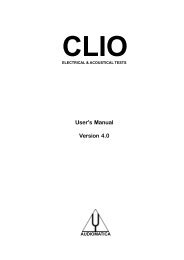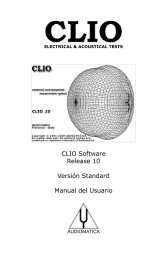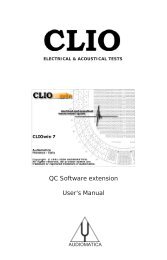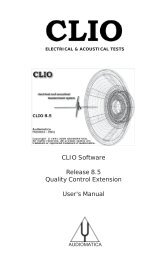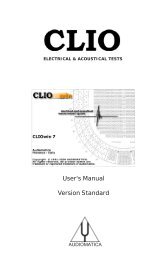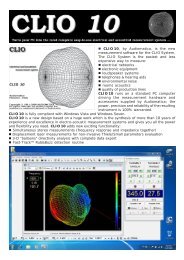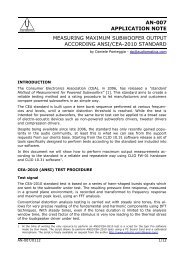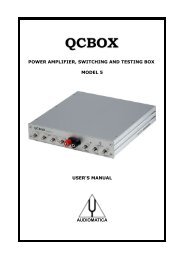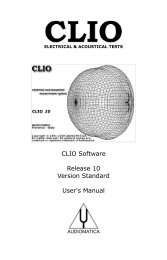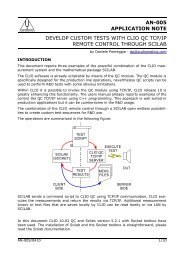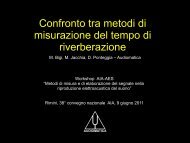CLIOwin 6.5 PCI User's Manual - Audiomatica Srl
CLIOwin 6.5 PCI User's Manual - Audiomatica Srl
CLIOwin 6.5 PCI User's Manual - Audiomatica Srl
Create successful ePaper yourself
Turn your PDF publications into a flip-book with our unique Google optimized e-Paper software.
evaluation; in this case only the data between the start and stop time is analyzed; each<br />
successive slice considers time data from its relative start time (the rearmost, at time<br />
zero, has start time equal to the start window of MLS) to the fixed stop time, the data<br />
being windowed by a particular time window with a smoothed rising edge (see literature<br />
for a discussion about this). Normal values for the Window Rise Time lie within 0.1 and<br />
0.6ms. In CSD mode, should the Time Shift value be left at zero, the routine will<br />
automatically calculate it, spacing the selected Number of Spectra in the interval defined<br />
by start and stop times; if Time Shift is forced by the user be sure to set it small enough<br />
to permit the last spectra to be calculated; if the fixed stop time is passed, then the<br />
calculation defaults as in case of zero Time Shift.<br />
When representing a CSD the program automatically hides the low frequency<br />
part of the spectra that has become unreliable due to the time-frequency<br />
uncertainty principle.<br />
ETF (Energy Time Frequency) is intended for room acoustic evaluation; in this case<br />
all MLS data starting from the start time are computed; then, successive slices are<br />
calculated moving their initial point of the Time Shift value.<br />
12.3.2 FILE DISPLAY MODE SETTINGS AND OPERATION<br />
Root File Name and browse button<br />
Name of one file within the set to be displayed. Pressing the associated button it is<br />
possible to browse the disk and choose the file.<br />
Z-Start<br />
Value associated to the first (rearmost) file.<br />
Z-Stop<br />
Value associated to the first (foremost) file.<br />
Z-Ref<br />
Value associated to the file to be taken as reference.<br />
Start Frequency<br />
Start frequency of the waterfall.<br />
Stop Frequency<br />
Stop frequency of the waterfall.<br />
File display mode is a powerful way for synthesizing a large number of measurements<br />
in a single 3-D graph. This mode allow the representation of the polar response of a<br />
loudspeaker taken as successive frequency responses saved in files.<br />
In order to identify the set of files it is important that all of their names follow a particular<br />
syntax, that give certain information to the processing routines.<br />
The syntax follows: .MLS.<br />
NAME is a common file name, UNITS are the common measurement units (to be<br />
displayed in the graph as Z axis label) and VALUE is a unique value identifying the single<br />
file; these quantities needs to be separated by spaces, it is possible to give negative<br />
numbers to VALUE. For example 'mydriver deg -250.mls' is a valid file name: as the<br />
name tells it is a measurement named mydriver with units deg taken at -2.5 (250<br />
divided by 100) units value.<br />
It is possible to identify one file within the set as reference with the Z-ref value; all<br />
calculations will then be made referenced to it.<br />
Please refer to 12.5 for an example.<br />
Chapter 12 - Waterfall 119



